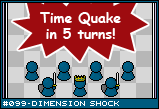| Three Hundred |
| - Index Page |
| - About... |
| - By Year |
| Collections |
| - Comp-Grid |
| - Procedural |
| - Tactics |
| - Tiny Crawl |
| - Misc |
| Previous | Mechanic #099 | Next |
I was thinking about [#009 - Time Shock], for no particular reason, and came up with a bunch of really cool ideas to really take it to the next level. Many of these ideas involved moving between parallel dimensions or operating on several of them simultaneously. Presenting this information to the player would be a logistical nightmare, since he'd need to be aware of what's going on in ever possible field simultaneously. ![[board1.png]](set05/img/entry099-board1.png) My solution was to break it down into only a single time split. You begin the game in traditional tactics setup. Since there are only two boards and you don't control the split, each unit is free to have more complex stats and interaction than previously possible (like hit points, by golly). At the beginning of the game, you are told how many turns until the "time quake", which will create two diverging parallel futures to play in. This gives you a chance to set up your units, or if you are quick, a chance to hobble your opponent before the split. |
![[board2.png]](set05/img/entry099-board2.png)
After the time quake, the board diverges into two identical boards - all units are likewise cloned, as is the state they were in when the quake happened. From here, the two players take turns moving a piece, first on one map then the other. The goal of the game is to defeat your opponent's king. But there is a catch (isn't there always?). There are two boards, thus a player wins by defeating both of his opponent's kings. If there is a tie (one blue and one red king left standing), there is another time quake after 5 turns - but instead of splitting the field, it merges the two back together. The merge rules are simple. All units from both sides are put together on the same map. In the case where two different units occupy the same square, the stronger unit will prevail (so a pawn and a knight on the same square, even if both red, only the red knight will remain after the merge). Play then continues until one or the other king is finally defeated.
First, there are two rules for movement. Pawns and Kings - These guys move independently between boards. This means that when the quake happens, they are cloned. The pawn on one board can move up while the pawn on the other moves left. One pawn can die and the other still exists. Knights - Knights work a bit differently. They are the same unit that exists on both boards simultaneously. In programming terms, while the pawns and kings are instances, the knights are referenced. This means that when a knight moves up, that same knight on the other board also moves up. When a knight is damaged, that damage is reflected on both boards. When a knight dies, he dies on both boards. And when a knight attacks, he attacks the same square on both boards. Knights have a distinct advantage of being able to be moved twice, once for each board. The disadvantage is that the additional difficulty in movement an action that requires a clear path on both boards. Also, they can be ganged up on by being surrounded in both dimensions simultaneously. |
![[board3.png]](set05/img/entry099-board3.png)
The second twist is that during game play, there exists a possibility that a stasis field will appear somewhere on the board. This field represents a section of the board that, like the knights, exists in both dimensions simultaneously. Like knights, this means that you can select the same unit to move on both boards. The cool part is that unlike knights, the stasis field can be entered and exited. With knights, they basically operate like normal. But with pawns, something interesting happens. When they are in the stasis field, they exist on and can be commanded from both boards - even commanded to leave the field. If you are paying attention, this means that you can actually transfer pawns between boards by entering them into the field on one board and having them exit the field on the other. Of course, this is not without its dangers. If you move a pawn into the same dimension as its clone, they will start to glow. The closer they get together, the stronger the glow will be. If they are ever in adjacent squares, either through accident or by being pushed there by another piece, they will explode, damaging everybody nearby. The same matter cannot exist in the same place and point in time - I think that's what they said in Back to the Future 2. Also, when a stasis field appears (you are given plenty of warning) it creates a merge for that area of the board. Again, every unit that occupies the same space, the strong unit will be left standing. In the case of equal units (red pawn + blue pawn), the outcome is random. Kings cannot enter a stasis field, and if they are in the area when it appears, they are destroyed instantly.
|
